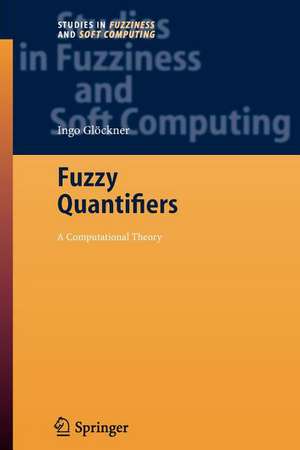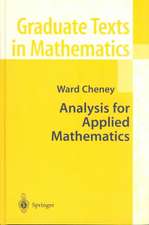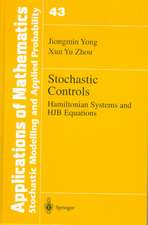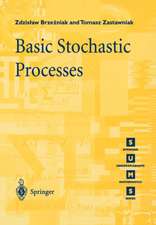Fuzzy Quantifiers: A Computational Theory: Studies in Fuzziness and Soft Computing, cartea 193
Autor Ingo Glöckneren Limba Engleză Paperback – 12 feb 2010
| Toate formatele și edițiile | Preț | Express |
|---|---|---|
| Paperback (1) | 953.20 lei 6-8 săpt. | |
| Springer Berlin, Heidelberg – 12 feb 2010 | 953.20 lei 6-8 săpt. | |
| Hardback (1) | 959.36 lei 6-8 săpt. | |
| Springer Berlin, Heidelberg – 10 ian 2006 | 959.36 lei 6-8 săpt. |
Din seria Studies in Fuzziness and Soft Computing
- 20%
 Preț: 999.85 lei
Preț: 999.85 lei - 20%
 Preț: 653.06 lei
Preț: 653.06 lei - 20%
 Preț: 872.98 lei
Preț: 872.98 lei - 20%
 Preț: 930.57 lei
Preț: 930.57 lei - 20%
 Preț: 1051.00 lei
Preț: 1051.00 lei - 20%
 Preț: 992.44 lei
Preț: 992.44 lei - 20%
 Preț: 655.85 lei
Preț: 655.85 lei - 20%
 Preț: 1001.86 lei
Preț: 1001.86 lei - 18%
 Preț: 954.14 lei
Preț: 954.14 lei - 20%
 Preț: 330.10 lei
Preț: 330.10 lei - 20%
 Preț: 333.04 lei
Preț: 333.04 lei - 20%
 Preț: 997.56 lei
Preț: 997.56 lei -
 Preț: 391.61 lei
Preț: 391.61 lei - 20%
 Preț: 647.79 lei
Preț: 647.79 lei - 20%
 Preț: 986.01 lei
Preț: 986.01 lei - 18%
 Preț: 958.56 lei
Preț: 958.56 lei - 20%
 Preț: 996.40 lei
Preț: 996.40 lei - 20%
 Preț: 999.35 lei
Preț: 999.35 lei - 15%
 Preț: 646.43 lei
Preț: 646.43 lei - 20%
 Preț: 651.57 lei
Preț: 651.57 lei - 20%
 Preț: 997.89 lei
Preț: 997.89 lei - 15%
 Preț: 641.03 lei
Preț: 641.03 lei - 20%
 Preț: 1009.74 lei
Preț: 1009.74 lei - 20%
 Preț: 992.62 lei
Preț: 992.62 lei -
 Preț: 388.72 lei
Preț: 388.72 lei - 18%
 Preț: 1223.43 lei
Preț: 1223.43 lei - 20%
 Preț: 651.42 lei
Preț: 651.42 lei - 18%
 Preț: 951.59 lei
Preț: 951.59 lei - 18%
 Preț: 948.61 lei
Preț: 948.61 lei
Preț: 953.20 lei
Preț vechi: 1162.43 lei
-18% Nou
Puncte Express: 1430
Preț estimativ în valută:
182.40€ • 195.04$ • 152.08£
182.40€ • 195.04$ • 152.08£
Carte tipărită la comandă
Livrare economică 18 aprilie-02 mai
Preluare comenzi: 021 569.72.76
Specificații
ISBN-13: 9783642067433
ISBN-10: 3642067433
Pagini: 480
Ilustrații: XVII, 460 p.
Dimensiuni: 155 x 235 x 25 mm
Greutate: 0.67 kg
Ediția:Softcover reprint of hardcover 1st ed. 2006
Editura: Springer Berlin, Heidelberg
Colecția Springer
Seria Studies in Fuzziness and Soft Computing
Locul publicării:Berlin, Heidelberg, Germany
ISBN-10: 3642067433
Pagini: 480
Ilustrații: XVII, 460 p.
Dimensiuni: 155 x 235 x 25 mm
Greutate: 0.67 kg
Ediția:Softcover reprint of hardcover 1st ed. 2006
Editura: Springer Berlin, Heidelberg
Colecția Springer
Seria Studies in Fuzziness and Soft Computing
Locul publicării:Berlin, Heidelberg, Germany
Public țintă
ResearchCuprins
An Introduction to Fuzzy Quantification: Origins and Basic Concepts.- A Framework for Fuzzy Quantification.- The Axiomatic Class of Plausible Models.- Semantic Properties of the Models.- Special Subclasses of Models.- Special Semantical Properties and Theoretical Limits.- Models Defined in Terms of Three-Valued Cuts and Fuzzy-Median Aggregation.- Models Defined in Terms of Upper and Lower Bounds on Three-Valued Cuts.- The Full Class of Models Defined in Terms of Three-Valued Cuts.- The Class of Models Based on the Extension Principle.- Implementation of Quantifiers in the Models.- Multiple Variable Binding and Branching Quantification.- Discussion.
Notă biografică
Ingo Glöckner received his M.A. in Computational Linguistics and Artificial Intelligence from University of Osnabrück in 1996. He then became a research assistant at the University of Bielefeld, where he pursued research on fuzzy set theory and its application to information retrieval. In 2003, I. Glöckner received his PhD for his thesis on the semantical interpretation and implementation of fuzzy quantifiers. He then joined the Intelligent Information and Communication Systems Group (Prakt. Informatik VII) of Prof. H. Helbig at the FernUniversität in Hagen. His current research activities are centered on the representation and processing of knowledge expressed in natural language.
Textul de pe ultima copertă
"Almost all", "many", "some": fuzzy quantifiers are vital for effective communication in natural language (NL). This monograph pursues an axiomatic method to achieve a reliable interpretation of these quantifiers in technical applications of fuzzy quantification. Unlike existing work in this area, it targets a much broader class of quantificational phenomena which includes all cases usually considered in linguistics. The topics addressed in the monograph run the gamut from the introduction of the theoretical framework for analysing fuzzy quantification, the formalization of semantical requirements on models of fuzzy quantification, the construction and detailed study of prototypical models which conform to the linguistic desiderata, the development of algorithms for implementing the main types of quantifiers in these models, and finally a preview to fuzzy branching quantifications which might be necessary for modelling NL sentences involving more than one quantifier. The material will be of interest to those working at the crossroads of natural language and fuzzy set theory. The fields of application comprise fuzzy information aggregation and data fusion, flexible database querying and fuzzy information retrieval, multi-criteria decision-making and linguistic data summarization.
Caracteristici
First monograph on fuzzy quantification Strong emphasis on linguistic justification and formal soundness of interpretations














